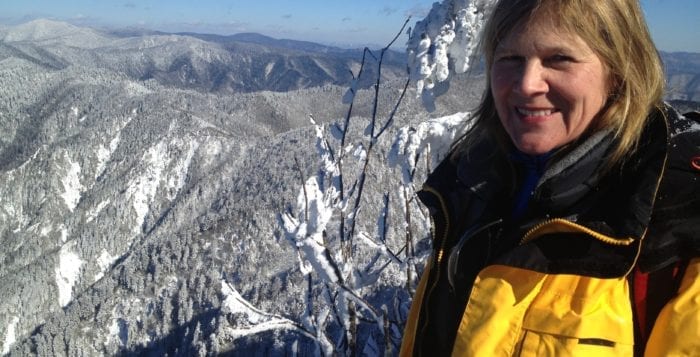By Daniel Dunaief
They produce so much information that they can’t keep up with it. They use the latest technology to gather data. Somewhere, hidden inside the numbers, might be the answer to current questions as well as the clues that lead to future questions researchers don’t know how to ask yet.
Scientists in almost every facility, including at Brookhaven National Laboratory, Cold Spring Harbor Laboratory and Stony Brook University, are producing information at an unprecedented rate. The Center for Data-Driven Discovery at Brookhaven National Laboratory can help interpret and make sense of all that information.
Senior researcher Line Pouchard joined BNL’s data team early this year, after a career that included 15 years at Oak Ridge National Laboratory (another Department of Energy facility) and more than two-and-a-half years at Purdue University. “The collaborations at the [DOE] lab are highly effective,” she said. “They have a common purpose and a common structure for the scientist.” Pouchard’s efforts will involve working with metadata, which adds annotations to provide context and a history of a file, and machine learning, which explores large blocks of information for patterns. “As science grows and the facility grows, we are creating more data,” she said.
Scientists can share large quantities of information, passing files through various computer systems. “You may want to know how this data has been created, what the computer applications or codes are that have been used, who developed it and who the authors are,” she said.
Knowing where the information originated can help the researchers determine whether to trust the content and the way it came together, although there are other requirements to ensure that scientists can trust the data. If the metadata and documentation are done properly “this can tell you how you can use it and what kind of applications and programs you can use to continue working with it,” Pouchard said. Working in the Computational Science Initiative, Pouchard will divide her time between responding to requests for assistance and conducting her own research.
“At Purdue, [Pouchard] was quite adept at educating others in understanding metadata, and the growing interest and emphasis on big data in particular,” explained Jean-Pierre Herubel, a professor of library science at Purdue, in an email. Herubel and Pouchard were on the research council committee, and worked together with other members to shepherd their research agendas for the Purdue University library faculty.
Pouchard “has a capacity to participate well with colleagues; regarding national and international venues, she will be a strong participating member,” Herubel continued. “She does well working and integrating with others.”
Pouchard recently joined a team that submitted a proposal in the area of earth science and data preservation. She has also worked on something called the Semantic Web. The idea, which was proposed by Tim Berners-Lee, who invented the World Wide Web, is to allow the use of data items and natural language concepts in machine readable and machine actionable forms. As an example, this could include generating rules for computers that direct the machines to handle the multiple meanings of a word.
One use of the Semantic Web is through searches, which allows people to look for information and data and, once they’re collected, gives them a chance to sort through them. Combined with other technologies, the Semantic Web can allow machines to do the equivalent of searching through enormous troves of haystacks.
“When I first started talking about the Semantic Web, I was at Oak Ridge in the early days,” Pouchard said. Since then, there has been considerable progress, and the work and effort have received more support from scientists.
Pouchard was recently asked to “work with ontologies [a Semantic Web technology] in a proposal,” she said, which suggests they are getting more traction. She is looking forward to collaborating with several scientists at BNL, including Kerstin Kleese van Dam, the director of the Computational Sciences Initiative and the interim director of the Center for Data-Driven Discovery.
Kleese van Dam has “an incredible vision of what is needed in science in order to improve computational science,” said Pouchard, who met the director about a decade ago when van Dam was working in England. Pouchard has an interest in data repositories, which she explored when she worked at Purdue University.
Living temporarily in Wading River, Pouchard bought a home in Rocky Point and hopes to move in soon. Her partner Allan Miller, from Knoxville, Tennessee, owned and managed the Disc Exchange in Knoxville for 26 years. He is starting to help small business owners and non-profit organizations with advertising needs. Pouchard experienced Long Island when she was conducting her Ph.D. research at the City University of New York and took time out to visit a friend who lived in Port Jefferson.
When she’s not working on the computer, Pouchard, who is originally from Normandy, France, enjoys scuba diving, which she has done in the Caribbean, in Hawaii, in Mexico and a host of other places.
When Pouchard was young, she visited with her grandparents during the summer at the beach in Normandy, in the town of Barneville-Carteret. Her parents, and others in the area, lectured their children never to go near or touch metal objects they found in the dunes because unexploded World War II devices were still occasionally found in remote areas. The environment on Long Island, with the marshes, reminds her of her visits years ago.
Pouchard has an M.S. in information science from the University of Tennessee and a Ph.D. in comparative literature from the City University of New York.
As for her work, Pouchard said she is “really interested in the Computational Science Initiative at BNL, which enables researchers to collaborate. Computational science is an integral part of the facilities,” at her new research home.





